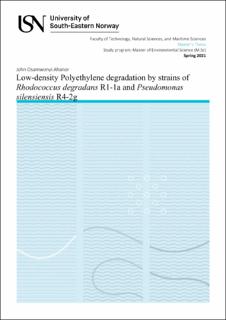| dc.contributor.advisor | Andrew John Jenkins | |
| dc.contributor.author | Ahanor, John | |
| dc.date.accessioned | 2021-11-12T17:41:15Z | |
| dc.date.available | 2021-11-12T17:41:15Z | |
| dc.date.issued | 2021 | |
| dc.identifier | no.usn:wiseflow:2577805:42441529 | |
| dc.identifier.uri | https://hdl.handle.net/11250/2829423 | |
| dc.description.abstract | For all sin betydning i vår daglige bruk, har plastpolymer utgjort en stor fare for miljøet. På grunn av deres stabilitet, høye molekylvekt, hydrofobisitet og lave nedbrytningshastighet, vedvarer de derfor i miljøet og utgjør alvorlig fare for levende organismer blant andre miljøhensyn. Seks mikrobielle stammer ble brukt i denne studien, men to stammer Rhodococcus degradans R1-1a og Pseudomonas silensiensis R4-2g viste tegn på LDPE-nedbrytning. Mikrobiell nedbrytning av LDPE ble analysert ved reduksjon av tørr vekt av LDPE-polymeren, utvikling av CO2 og platetellingmetoden. Disse bakteriene viste utholdenheten til å leve på LDPE som eneste karbonkilde, med vekttap på 6,5% og 3,5% av LDPE etter 60 dagers inkubasjon for henholdsvis Rhodococcus degradans R1-1a og Pseudomonas silensiensis R4-2g som enkeltkulturer og 21,5% vekttap som en blandet kultur, og CO2-utslipp på henholdsvis 150 ppm og 400 ppm av R1-1a og R4-2g som antyder LDPE-nedbrytning.
Nøkkelord: LDPE, nedbrytning, Rhodococcus degradans, Pseudomonas silensiensis. | |
| dc.description.abstract | For all its importance in our daily use, plastic polymer has posed a great danger to the environment. Due to their stability, high molecule weight, hydrophobicity, and low degradability rate, hence, persist in the environment posing grave danger to living organisms amongst other environmental concerns. Six microbial strains were used in this study but two strains Rhodococcus degradans R1-1a and Pseudomonas silensiensis R4-2g showed evidence of LDPE degradation. Microbial degradation of LDPE was analyzed by dry weight reduction of the LDPE polymer, the evolution of CO2, and the plate count method. These bacteria showed the tenacity to live on LDPE as the sole carbon source, with weight loss of 6.5%, and 3.5% of LDPE after 60 days of incubation for the Rhodococcus degradans R1-1a and Pseudomonas silensiensis R4-2g respectively as single cultures and 21.5% weight loss as a mixed culture, and CO2 emission of 150 ppm and 400 ppm of R1-1a and R4-2g respectively which suggests LDPE breakdown.
Keywords: LDPE, degradation, Rhodococcus degradans, Pseudomonas silensiensis. | |
| dc.language | eng | |
| dc.publisher | University of South-Eastern Norway | |
| dc.title | Nedbrytning av polyetylen med lav tetthet av stammer av Rhodococcus degradans R1-1a og Pseudomonas silensiensis R4-2g | |
| dc.type | Master thesis | |
